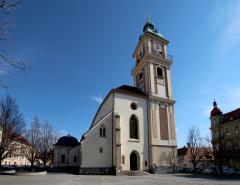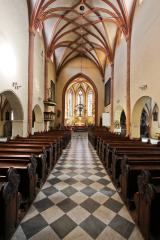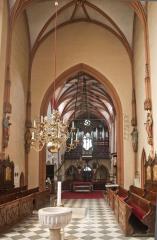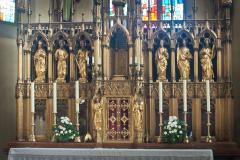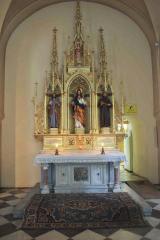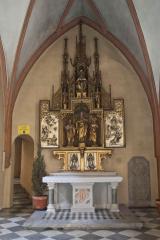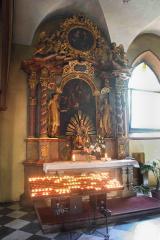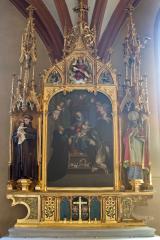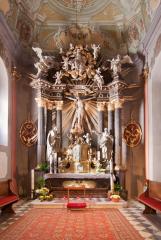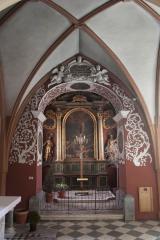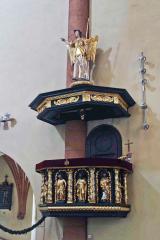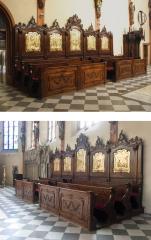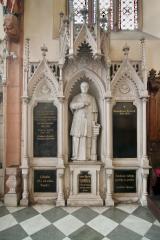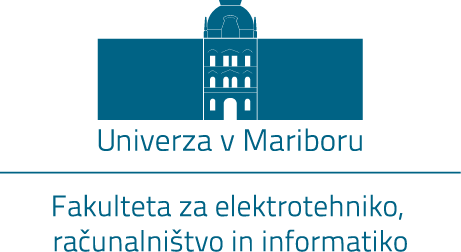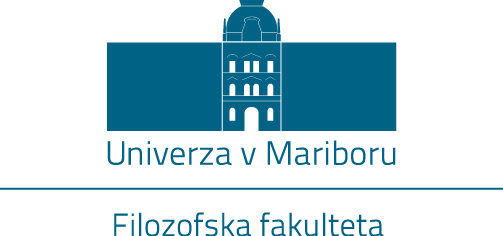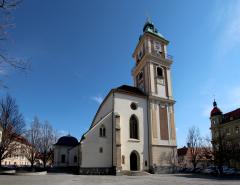
THE CATHEDRAL OF ST. JOHN THE BAPTIST
Location: Slomškov trg (Slomšek Square)
Architect: unknown
Time of construction: 12th century, ca. 1400, 1442, 1467, ca. 1520, 1648, 1650, 1714, 1715
The Maribor Cathedral and parish church dedicated to St. John the Baptist is the most important religious building in town. Since the establishment of the parish in the first half of the 12th century, the church has been rebuilt and refurnished numerous times. Additions and reconstructions were caused by the growth of population, fires, changes in taste and the purpose of the building, especially after the seat of the Diocese of Lavant was transferred from Sankt Andrä to Maribor in 1859.
Provincial princes were the patrons of the church from the foundation of the parish until 1506. From 1506 until 1786, it was part of the Diocese of Krka (Gurk) as mensal good with the exception of the years 1545 and 1553, when it was in possession of the town. From 1786, it was a part of the Diocese of Graz-Seckau, until the Diocese of Lavant was transferred to Maribor in 1859. The Lavantine Diocese became Archdiocese in 2006. At first, the church was dedicated to St. Thomas; in 1254, it was mentioned with a dedication to St. Thomas and St. John the Baptist, and later only with the dedication to St. John the Baptist.
The first church was probably built before 1150 outside of the market town. The single-nave church probably consisted of the present day nave from the arch to the organ loft and had a semi-circular apse in the east. In the middle of the 13th century, the nave was supposedly extended upward and the church expanded into a three-nave pillar basilica with four arcaded arches between the nave and both aisles. At the turn of the 13th to the 14th century, the clerk and town judge Rudolf commissioned the construction of the one-storeyed chapel of St. Catherine in front of the west façade of the parish church. The entrance vestibule to the church and the tomb of the founder were on the ground floor of the chapel, while the altar of St. Catherine was on the storey, which was at first separated from the nave by a wall. It was not until around 1450 that the original west façade of the nave was perforated and the former chapel of St. Catherine connected to the church. With that, they gained the organ loft, which rests on three octagonal pillars. It is possible that the builder or the commissioner is depicted on one of the four consoles in the gallery. Around 1320, the three-storeyed town tower was built on the corner between the southern aisle's west façade and the storeyed chapel. The tower was mostly used for defence and partly for the needs of the church. In 1465, town builder Hans Premer renovated the town's guardhouse on the tower's upper storey. Around 1520, the tower was raised by one storey, in which the bells are placed. After the earthquake in 1590, the town's construction engineer Ludvik Himmelsteiner repaired the tower and the church. After the fire in 1601, they were repaired by Benedikt Rore, and between 1623 and 1624 by Paolo della Porta. After the fires in 1648 and 1650, the staggered double storey conclusion covered with an onion roof was added to the tower. After the fire in 1791, the tower was lowered after the plans by Graz architect Josef Hillebrandt; they also built a balcony, a domical roof with a lantern and an Early Classicist articulation of the façade.
The presbytery, sacristy, stair-turret with spiral staircase and the extension of the northern aisle up to the western façade of St. Catherine's chapel were built around 1400. The presbytery has three transverse rectangular vault bays and a polygonal conclusion. It is supported by staggered buttresses. The interior of the presbytery is especially lavish with stonemasonry in the form of relief animal scenes at the foot of the triumphal arch, figural consoles, baldachins and bosses on the intersections of the plaited vault. Symbols of evangelists depicted with human bodies and animal heads are found on four bosses. Such images are more frequently found on goldsmiths' products from the 14th century and rarely on stonemasons' works. The outstanding sedilia with seven seats and baldachins, which are decorated with motifs of thre-foil, quatre-foil, fish-bladder, pinnacles and finials, were made at the same time. Rich stonemason decoration can also be found on the ground floor of the sacristy. Rib vaults are placed on six consoles that depict symbols of evangelists and angel busts. The round bosses depict Christ's head and the blessing hand of God. The oratory was situated on the storey above the sacristy.
In 1442, the southern aisle was expanded upward and vaulted. The northern aisle was vaulted later, possibly in 1467, when sources mention construction work in the church. The stonemasonry in the northern aisle is worthy of attention, especially the angels with Arma Christi depicted on the consoles. Around 1520, the nave was raised almost five metres and levelled with the presbytery. It had a net-vault, clerestory windows and a rosette on the western façade. Three inscription plates built into the northern wall of the nave and the plate on the eastern buttress of the sacristy recall of the reconstruction. Two of them mention the church warden of the time Linhart Holzmann (1520), the year 1521 and the initials MT (possibly stonemason M. Thoman from Slovenska ulica) are inscribed on the third one, while the forth mentions the name Hans Weiss and the year 1524.
Larger reconstructions in the church were made after the fires in 1648 and 1650. The roof needed to be renewed and three entry vestibules were added to the church. In the 18th century, both side chapels, built in 1714 and 1715 and consecrated between 1724 and 1725, were added to the church. The southern chapel dedicated to the patron saint against the plague St. Francis Xavier was enriched with vegetal stucco. Cartouches and medallions, which surround the empty fields intended for paintings, are also made of stucco. The current wall paintings were made by Jakob Brollo in 1873. Scenes from the life and missionary work of St. Francis prevail. The stained glass windows depicting motifs from the Great Flood and the Holy Spirit were made based on drafts painted by Stane Kregar. They were produced by the Staklo Zagreb company in 1967. The northern chapel dedicated to the Holy Cross was painted by court painter Josef Adam Mölk in 1775. The Finding of the Holy Cross is painted on the vault. The northern side chapel is now dedicated to the beatified Anton Martin Slomšek; it also houses his grave. The stained glass windows, inserted between 1996 and 1999 remind us of Anton Martin Slomšek. Marko Jerman depicted the following scenes on them: Anton Martin Slomšek teaching Blaž and Nežica, Anton Martin Slomšek as a bishop in Maribor, the Beatification of Slomšek and Slomšek in the Council of the Holy Ones. The fourth stained glass window depicts Sts. Cyril and Methodius.
The transferal of the seat of the Diocese of Lavant from Sankt Andrä to Maribor was important for the architecture and furnishings of the former parish church of St. John the Baptist in Maribor. From an art-historical and restoration-conservational point of view, it is important to note what kind of a stand was taken when the church was promoted to a cathedral. From today's point of view, the decision to preserve and thoroughly renovate all of the furnishings of the parish church and build all new furnishings in the Neo-Gothic style, is extremely modern. On 4 September 1859, Bishop Anton Martin Slomšek walked into the church building, which still had a completely Baroque character. The church's exterior and interior had been cleaned and renovated for this important occasion. It took Johann Max Tendler, a painter from Graz, half a year to paint the new Gothic tracery and the statues in the colour of stone on the walls of the interior. The high altar was newly gilded and silver-plated. A large rug with aristocratic coats of arms, which was donated by the Brandis family, was placed on its steps. The new bishop's throne was placed on the evangelical side, as well as new organs in the gallery.
In 1883, the building was in such bad condition that it raised the question of demolishing the old church and building a new one or re-Gothicizing the existing one. Especially Ignacij Orožen, diocesan historian and cathedral canon, advocated for the preservation of the old church. In 1885, the church was closed for religious service and in two years time, it was renovated in accordance with its "style", meaning that it was re-Gothicised. They "renovated" much more than was necessary for its preservation. In order to gain more room and a better view of the interior, all the altars beside the pillars and the retable of the high altar, which reached to the vault, were removed. Consequently, the church lost numerous important works of art from the 17th and 18th centuries. Nevertheless, not all of the furnishings were thrown away. With the help of written sources, some parts of the furnishings can be recognized in other churches and the Maribor Regional Museum.
Despite the changes, the cathedral's furnishings are still worth seeing. The most beautiful part of the church is its presbytery. The new consoles with the busts of prophets and the baldachins, which replaced the Gothic ones from around 1400, were made by Maribor sculptor Matevž Rath in 1891. The year after, statues of ten apostles and evangelists and archangels Michael and Gabriel were placed under the baldachins. They were made by Jacob Gschiel and polychromed by gilder Wilhelm Sirach, both from Graz. During the re-Gothization of the church, the Late Baroque stalls were not removed. Maribor sculptor Josef Holzinger carved the gilded reliefs on the backrests in 1771. The ten reliefs depict scenes from the life of St. John the Baptist. Even though a new bishop's throne for Anton Martin Slomšek was placed in the cathedral's presbytery as early as 1859, they decided to replace it in 1891. The throne made of stained oak wood, which was considered very precious at that time, was placed along the northern wall. Architect Robert Mikovics (1852-1894) from Graz designed the throne, while Graz woodworker Benedikt Mößmer (also Mösmer) carved it. Slomšek's monument, erected in 1878, stands next to the southern wall of the presbytery. The Neo-Gothic monument was designed by Viennese architect Georg Härtl and was made in Graz. The statue of Slomšek putting his right hand to his heart and his left hand on an open book is placed in the central niche of the three-part monument. The sculpture made of Carrara marble was carved by sculptor Franc Ksaver Zajec (1821-1888). The old Baroque high altar from the middle of the 17th century, which was not in accordance with stylistic preferences of the late 19th century, was removed from the presbytery. It was replaced by a Neo-Gothic altar; its retable was consecrated in 1890. The retable was made by Graz woodworker Benedikt Mösmer, while the statues were made by a very young sculptor from Graz, Peter Neuböck. Bishop Jakob Maximilian Stepischnegg donated the means for the erection of the altar. The retable is designed as a seven-part polyptych with an emphasised central part. On the sides of the altar, there are six lower and upper niches. Reliquaries in the form of Late Gothic monstrances are placed in six niches in the lower part. The statues of St. Bishop Maximilian, St. Joseph, St. Paul. St. Peter, St. Jacob and St. Andrew stand in the upper niches. The statue of the patron saint John the Baptist is placed under the baldachin. The baptismal font with the inscription 1634 is placed in the centre of the presbytery. The new communion altar, Ambon and the bishop's throne are among the modern church furnishings. The altar was made by Žmuc passementerie in 1978 after the plans by Jože Kregar. Sculptor Gabrijel Kolbič made the reliefs (1981).
The pulpit in the nave is the oldest preserved Baroque work in the church. Curved columns with gilded vineyard tendrils with large leaves and grapes wrapped around them are placed on a relatively low balustrade of the pulpit. Shallow semi-circular niches with wooden sculptures of the four evangelists and Sts. Peter and Paul are placed between the columns. On the right side of the pulpit, the painting of the Baptism of Jesus in Jordan from the middle of the 17th century, which was once a part of the Baroque high altar, is placed on the wall of the northern aisle. The large painting on the southern wall of the nave, a replica of Rubens' composition of the Raising of the Cross painted between 1610 and 1611 for the altar of the Cathedral of Our Lady in Antwerp, was made at approximately the same time. The chandeliers from 1686 are also worth mentioning (two are hung in the nave, three in the presbytery). They were donated by members of the butchers, bakers and goldsmiths' guilds, to which attest the head of an ox, a ring and a pretzel.
Two altars are placed in the northern aisle. Along its eastern wall is the Neo-Gothic altar of the Sacred Heart of Christ designed as a Gothic polyptych. The statues of the Sacred Heart, St. Joseph and St. Francis of Assisi stand in the three niches on the retable. The altar was erected in 1898. It was donated by Bishop Michael Napotnik in memory of the fiftieth anniversary of the rule of Emperor Franz Joseph I. The altar was designed by architect Hans Pascher in Graz, the marble mensa was made by stonemason Karel Kocijančič from Maribor, the retable by Graz woodworker Johann Rossman, and the gilding and sculptural works were made by Graz masters Wilhelm Sirach and Peter Neuböck. The altar of the Rosary, erected in 1904, is situated next to the northern wall of the aisle. The altar painting is a replica of the painting of Our Lady of the Rosary, which the Italian Baroque painter Giovanni Battista Salvi da Sassoferrato painted in 1643 for the church of St. Sabina in Rome. The Maribor replica of Sassoferrato's painting was made by Felix Barazzutti from Gemona. Architect Hans Pascher from Graz designed the altar, while Maribor stonemason Karel Kocijančič made the marble mensa. Woodworker Johann Rossman, gilder Wilhelm Sirach and sculptor Peter Neuböck (statues of St. Nicholas and St. Anthony of Padua) also participated. The altar of the Holy Cross in the northern side chapel was made at the same time as the frescoes in the chapel around 1775. The statues of St. Mary, St. John the Evangelist, God the Father and the angels were made by Maribor sculptor Josef Holzinger (1735-1797). The statue of the Crucified is older and supposedly once stood in the cemetery near the cathedral. According to a tale, some blasphemer threw a snowball at the Crucified out of wantonness. The Maribor townspeople decided to repair this desecration by placing the Cross in its perfect place in the interior of the church. In 1847, in memory of the snowball that never melted, it was still possible to see a white ball under the glass on the chest of the Crucified. A marble plate made by F. M. Schulz from Graz is placed in the chapel. On it is Slomšek's coat of arms and the inscription Antonius Martinus Slomšek Princeps Episcopus Lavantinus, natus in parochia Ponikl 26. Novembris 1800, sacerdos 8. Septembris 1824, episcopus consecratus 5. Julii 1846, primus Marburgi sedit inde a 4. Septembris 1859, obiit 24. Septembris 1862. R.I.P.
The altar of the Heart of Mary in the southern aisle was donated by parishioners. It was consecrated in 1898. The neo-Gothic altar retable copies the design of the Gothic winged altar piece with movable wings. The altar was made by the same masters as the concurrent altar of the Sacred Heart and the somewhat younger altar of the Rosary. The design was made by Graz architect Hans Pascher, the marble mensa by Karel Kocijačič from Maribor, the woodwork on the retable by Johann Rossman, the gilded work by Wilhelm Sirach, the paintings by Felix Barazzutti, and the sculptural work by Peter Neuböck, all from Graz. The altar of St. Florian along the southern wall of the nave was made between 1697 and 1699. Maribor sculptor Franz Christoph Reiss made the statues and the altar's rich acanthus ornamentation. The altar painting made by Georg Abraham Peuchl is surrounded by the figures of St. Stefan and St. Lawrence. The paintings of St. Catherine and St. Barbara at the top of the altar were made by Graz painter Hans Adam Weissenkircher (1646-1695). An older wooden, gilded and polychromed statue of Mary with Child on the throne is placed on the altar of St. Florian. It was probably made soon after 1500. The altar of St. Francis Xavier in the southern side chapel was probably made by Maribor sculptor Franz Josef Reiss (mentioned from 1711-died 1732). The altar painting depicts the Apotheosis of St. Francis Xavier. Supposedly, the painting was made in remembrance of the plague epidemic in Maribor between 1711 and 1713; a veduta of Maribor is depicted in its lower part.
Between 1885 and 1886, when the church was re-Gothicised, the old tombstones were removed from the interior walls and the church pavement and built into the exterior of the church.
Polona Vidmar
(29 September 2014)
